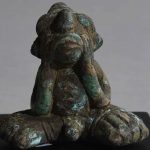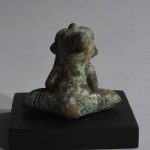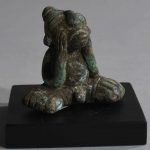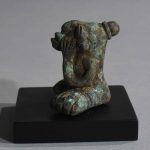ANK 0517-100
São bronze male figure, Chad
This charming bronze male figure derives from the almost forgotten São culture. With his small cap on the head, a thoughtful expression with both hands supporting the cheeks and furious big feet, this little male figure radiates with charm.
The figure was found by archaeologists in a funerary urn along with fine personal ornaments. During the 20th Century, archaeologists found several thousand urns in an area near the Chari River, or Shari River, south of capital N’Djamena in Chad.
One of these archaeologists was Marcel Griaule, the leader of the French Dakar-Djibouti Expedition (1931-1933). As an ethnographer, Griaule was fascinated by the folk traditions of the peoples inhabiting the Chadic plain, and collected their oral lore. These were then translated and published as Les São Legendaires. It was due to this book that the concept of ‘São Civilization’ or ‘São Culture’ was coined and popularized. This idea of ‘culture’ was manifested in the works of art produced by its people. Therefore, Griaule’s expedition was concerned mainly with finding pieces of art produced by the São. Griaule was not disappointed as the São produced intriguing statuary in clay, large, well-fired ceramic vessels that were used as urns and contained the deceased’s possessions, including bronze figures, weapons and various religious effects.
There are very few records of the São peoples. However, the term ‘São’ was likely to have first been introduced into the written sources during the 16th century AD. Two chronicles (both of which were written in Arabic) by Ahmad Ibn Furtu, the São is mentioned: The Book of the Bornu Wars, The Book of the Kanem Wars, and the grand Imam of the Bornu Empire. Ahmad Ibn Furtu described the military expeditions of his king Idris Alooma. Those populations that were conquered and vanquished by Idris Alooma were generally referred to as the ‘São’, the ‘others’ who did not speak the Kanuri language (a Nilo-Saharan language). These settlers, who were possibly the first settlers of the region, spoke another Chadic language which derived from the evolution of the Central Chadic language sub-family.
According tolegends,theSãowas a peopleofpowerfulgiants who believedtheycouldtracetheiroriginbacktoJerusalem:“AwomanfromJerusalemboretwins,whomarriedeachotherandproducedaraceofgiants,theSão…”Aroundthe7thCentury, theSãooccupiedtheoasesBilma,TadjéréandFatchinorthofLakeChadandthensettledwestfromthelakearoundthe10thcentury,wheretheyfoundedtheactualSãoEmpire.
Condition: Despite its age the figure is in exceptional good condition. The storage in the urn has created a thick green irrigated surface that makes the figure even more attractive and exciting.
Provenience: Private Belgian collection.
Dimensions: H: 6, W: 7,5 and D: 5 cm – Weight: 290 gram.
Archaeological evidence shows that the São buried their dead. The tradition of placing a corpse in the fetal position inside of an earthenware jar was in practice from the 12-13th Centuries AD. The funerary jar was closed by placing another jar or a small ovoid pot on top. However, this tradition was abandoned by the 15th century when simple burials became the norm.
Request price for São Bronze




